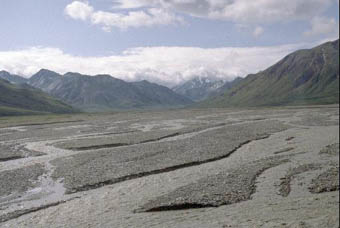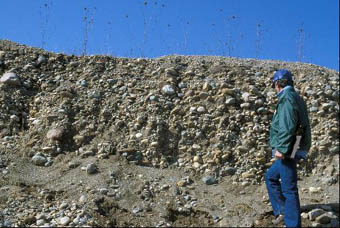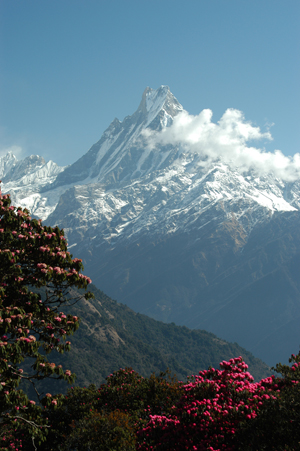Machupuchare in the Annapurna Range of the Himalaya in central Nepal is a mountain influenced by monsoons.
Click on image for full size
Courtesy of Kip Hodges
Storms Shaped the Himalayan Mountains
News story originally written on November 9, 2008
Rain is important for many reasons. It waters plants and allows animals to drink. It fills rivers and lakes. But did you know that it can affect mountains too?
Scientists have found evidence that strong storms shaped the Himalayan Mountains over millions of years.
The Himalayan Mountains are in Asia, where winds blow that carry moist air. These moist winds make monsoons, big storms that have lots of rain. There’s evidence that the monsoons have happened for at least 24 million years. But the storms have not always been the same. Sometimes monsoons were very big and other times they were smaller storms.
To figure out how the monsoons have changed high in the Himalayas, scientists looked to the bottom of the ocean. They studied layers of sediments from the seafloor. The sediments were weathered from mountains, then moved in rivers before settling down on the seafloor.
The seafloor sediments shows how much of the mountain rock weathered away over time. The scientists found that more monsoons cause more weathering of rocks.
The scientists concluded that the Asian monsoons became stronger from 23 to 10 million years ago, and then became weaker until about 4 million years ago. After that, monsoons became stronger again.
Last modified December 2, 2008 by Lisa Gardiner.
You might also be interested in:

Raindrops form when tiny water droplets collide together in clouds to form bigger ones. When they get too heavy, rain falls out of the clouds. Rain is more than 5mm in diameter. The types of clouds that
...more
Wind is moving air. Warm air rises, and cool air comes in to take its place. This movement creates the winds around the globe. Winds move at different speeds and have different names based on their speed.
...more
If you sneeze into a pile of dust the little particles fly everywhere, but if you sneeze into a pile of rocks, they will stay put. It takes more force than a sneeze to move those rocks. Winds and water
...more
When water or wind slows down, sediment can no longer be carried in it. The particles of sediment fall through the water or air and form a blanket of sediment on the bottom of a river, a lake, ocean,
...more
Scientists have learned that Mount Hood, Oregon's tallest mountain, has erupted in the past due to the mixing of two different types of magma. Adam Kent, a geologist at Oregon State University, says this
...more
The Earth's mantle is a rocky, solid shell that is between the Earth's crust and the outer core. The mantle is made up of many different reservoirs that have different chemical compositions. Scientists
...more
Some faults look strong and like they wouldn’t cause an earthquake. But it turns out that they can slip and slide like weak faults causing earthquakes. Scientists have been looking at one of these faults
...more















